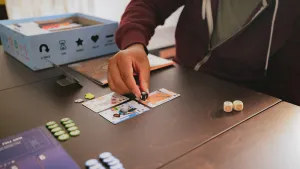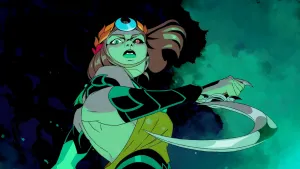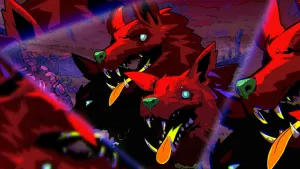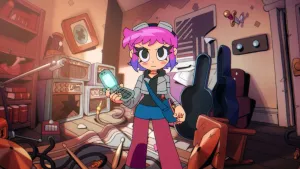"It's A Monster!" – The Evolution Of Resident Evil's Zombies

Long before zombies overran video games, Capcom horrified players with their unforgettable ghouls. Since that first grisly introduction in the Spencer Mansion, Resident Evil's trend-setting monsters have mutated and changed much like its recurring viruses. To celebrate today's release of Resident Evil: Revelations 2's first episode – along with its new zombie-like torture monster – we're looking back at the evolution of the series' iconic enemy.
Note: This list sticks to the core entries in the Resident Evil series and lists the consoles they originally released on.

Resident Evil - 1996 (PlayStation)
The Resident Evil series' mid '90s debut didn't mark the
first time players had encountered zombies, but many considered it the scariest
to date. Simon Belmont whipped legions of undead in the halls of Dracula's
castle, and Doom Guy blasted possessed zombie marines in id Software's genre-defining
FPS, but Resident Evil was different. Zombie
dogs attack the S.T.A.R.S. Alpha Team in a campy yet mood-setting introductory cutscene, but players don't encounter their first walking dead enemy until a
few tense moments pass.
Jill or Chris (depending on your preference) is investigating gunshots when they stumble upon a disheveled man feasting on their former compatriot, Kenneth Sullivan. The camera moves in as the moaning, slurping figure slowly turns to face them, revealing lidless, lifeless eyeballs and a slack maw moist with Kenneth's blood. Armed with pitifully few bullets or perhaps only a knife, many players succumbed to this initial zombie's primitive yet deadly approach (maybe the tank controls had something to do with it).
These first-generation RE zombies moan and shuffle towards the player with arms outstretched, like extras auditioning for a Romero film. These enemies make a beeline for the player with little finesse, aiming to simply grab on and munch into the vulnerable flesh of their neck. Unfortunately for the S.T.A.R.S. team, these zombies can absorb nearly a full pistol clip before falling, offering ample time to close the gap. Nimble players can wait for these clumsy foes to veer slightly off course and attempt to run past them to conserve ammo. The original Resident Evil's zombies weren't flashy, but their relentlessness and hungry moans still send chills down our spines.

Resident Evil 2 - 1998 (PlayStation)
This sequel's zombies are downright limber when compared to
Resident Evil 1's stiff, rigor mortis-stricken undead. Where RE 1's zombies
barely flinch when blasted with a handgun, these enemies jerk and fall
backwards when they take enough damage. Knocking zombies back allows players a
precious second to flee past them, which is especially useful considering RE 2
doubled the amount of enemies that would appear in a room. Unfortunately, these
more reactive zombies could also fall towards the player, clinging to their
legs for a few desperate chomps before an inevitable boot to the skull.
Speaking of taking damage, RE 2's zombies displayed gruesome damage done by the player to an impressive degree. Zombies in RE 1 might lose a limb or their head, but RE 2's undead could have half of their torso obliterated by a rocket or upgraded shotgun blast. Players could even use the aforementioned super shotgun to take aim at a zombie's waistline, fire, and sever their upper torso from their still-waling legs. Watching a zombie's detached upper body crawl towards you was a pathetic yet unnerving sight.

Resident Evil 3: Nemesis - 1999 (PlayStation)
The zombies of Jill Valentine's second starring title are
similar to those introduced in RE 2 with a few key distinctions. RE 3 marks the
first time in the series that multiple enemy types would routinely populate the
same room, mainly because the abominable juggernaut, Nemesis, stalks players
throughout the game. This means that Jill has to dodge common zombies while
running like hell from Umbrella lab's sinister care package. Unlike Jill, the
towering Nemesis can simply swat obstructing undead out of his way like traffic
cones.
Resident Evil 2 also subtly introduces a new, unpredictably speedy zombie variant, dubbed "ninja zombies" by fans. These spry, undead pests blend in with a pack of seemingly standard zombies, only to lunge out towards Jill at an alarming pace. They're still no match for a shotgun blast to the head, but they can easily kill mortally wounded players that are less cautious.

Resident Evil Code: Veronica - 2000 (Dreamcast)
Code: Veronica is a milestone in the Resident Evil series,
replacing the traditionally static, 2D backgrounds with fully modeled 3D
environments. Despite this, zombies display familiar behavior in Claire and
Chris Redfield's sibling-focused adventure. Players still have to watch out for
the occasional "ninja zombie" sprinting towards them, but otherwise these are
the same stock humanoid threats we've learned to know and exterminate.

Resident Evil [Remake] - 2002 (GameCube)
Series creator Shinji Mikami remade the original 1996
Resident Evil from the ground up, and a ton of interesting, terrifying changes
came with it. At first glance, zombies move and act like more detailed versions
of their PlayStation-era predecessors. Fortunately for players, zombies can be
stopped mid-chomp with a suite of limited self-defense weapons. Jill can use a
stun gun to shock zombies, while Chris can shove grenades into their mouths and
shoot them for an instant decapitation.
Taking off zombies' heads is especially important in the RE remake, since fallen foes left with their bodies intact can return to horrifying effect. If zombies don't have their heads blown off or aren't immolated with the mansion's finite kerosene supply, they return as Crimson Heads. These blood-red abominations unnaturally rise up from the ground like Nosferatu emerging from his coffin. Their clawed hands twitch, curious fog puffs from their mouth, and they run after players with renewed vigor. These stronger, faster, hardier zombies forced players to rethink the consequences of each encounter with a regular ghoul and added new tension and unpredictability when backtracking through the mansion.

Resident Evil Zero - 2002 (GameCube)
The art style and gameplay of this prequel is nearly
identical to the 2002 remake, but unfortunately the harrowing Crimson Heads are
nowhere to be seen. Instead, protagonists Rebecca Chambers and Billy Coen are
confronted by new zombies that are swarmed and overtaken by T-Virus-infected
leeches. These bizarre slug collectives have increased aggressiveness and
power, forcing players to rely on something stronger than a pistol. The trusty
shotgun can blast chunks of leeches off these zombies, but the humanoid figure
quickly regenerates the lost appendage like a slimy Liquid T-1000. Thankfully,
incendiary weapons like the Molotov cocktail and napalm grenade rounds work
well.
Other than the Leech Zombie, Rebecca and Billy confront a standard set of undead. Unlike past games, players control both characters in RE: Zero, swapping between them on the fly. The extra A.I. firepower comes in handy when it comes to taking out a handful of undead with standard pistols.
Up next: Resident Evil's change even more dramatically as the series is reinvented...

Resident Evil 4 - 2005 (GameCube)
By now it's common knowledge that Mikami's RE 4 singularly
revitalized the franchise and redefined third-person shooters. The
over-the-shoulder, precision-based gunplay still feels wonderful to this day,
and much of that is thanks to satisfying feedback players get when blasting the
– very-zombie-like-but-not-officially-zombies – Ganado enemies. These infected,
homicidal enemies stalk, flank, and hurl weapons like axes and dynamite at Leon
S. Kennedy throughout his quest in Europe. These not-zombies enemies even
communicate to each other in Spanish, shouting commands to one another or
threatening Leon. Thankfully, RE 4 allows players to target specific enemy
limbs in order to trip them up, detonate a stick of TNT they're holding, or
turn their heads to pulp.
Unlike previous Resident Evil titles where headshots are always welcome, seeing a Ganado's head disappear can spell potential doom. Las Plagas parasites can mutate and crawl through the Ganado's neck hole, dangling from their shoulders like a bulbous, twitching tumor. These nasty critters can slash at Leon with scythe-like appendages, devour his head for an instant kill, or even detach from their host and skitter across the ground like overgrown Facehuggers. The Plagas can withstand a lot of damage, but they're incredibly sensitive to bright light. Leon can instantly kill a gang of these gross creatures with a single flash grenade.

Resident Evil 5 - 2009 (PS3, 360, PC)
This follow-up to RE 4 maintains the core gunplay and game
design tenants in place while adding a few twists to the formula. Instead of
shooting Ganados in Europe, Chris Redfield and Sheva Alomar exterminate the
functionally similar Majini enemies in Africa. In RE 4, special Ganados could
wield projectile weapons like crossbows or gatling guns, but the Majini more
commonly wield common guns like AK-47s. This injects more cover-based
firefights into RE5 while preserving the up-close-and-personal encounters fans
loved in RE 4.
As in RE 4, Majina are also infected with a type of Plaga parasite. One strain of the parasite detaches from its host and flies through the air like a deranged, mutant bat. Another incarnation splits apart the host's entire upper body and generates a thick, front-facing shell. The best way to take out these armored Plagas is to shoot the fleshy, vulnerable tail protruding from its back.

Resident Evil: Revelations - 2012 (3DS, Wii U)
Fans were surprised by the high quality of this side-story
entry in the series, which originally debuted on Nintendo hardware. Angled as a
return to the series horror roots, it stars Jill Valentine as she treks through
a dark, zombie-infested ship. Chris Redfield also co-stars on the hunt for
Jill. The common "Ooze" zombie type in Revelations is a far cry from humanoid
enemies previously featured in the series, perhaps most similar to RE: Zero's
Leech Zombies. These glistening, fleshy monsters lurch towards players at a
steady pace with the goal of latching on and sucking at their flesh with their
overgrown, tapeworm-esque mouths.
Unlike the not-zombies of RE 4 and 5, these pale, pinkish foes don't react accordingly when players shoot them in specific limbs. Instead of shooting out their legs, Jill and Chris are forced to rely on carefully timed dodges to avoid taking damage. The Ooze enemy includes variants that slash at the player with scythe-like claws, fire a sharp ranged projected, or explode at close proximity.

Resident Evil 6 - 2012 (PS3, 360)
The monstrosities of Resident Evil 6 are infected with a new
nasty biological cocktail called the C-Virus. The standard zombie – afflicted
with the C-Virus by indirect means – behaves similarly to the main enemies of
RE 4 and 5, though with slightly diminished mental capacity. They wield crude
melee weapons like axes, cleaves, and bottles, though they can also clumsily
fire handguns and automatic rifles at the player.
Opposite of the regular zombie fodder are the J'avo, monsters that are the result of direct administration of the C-Virus. These humanoid freaks are more organized than their zombie fodder counterparts, and have extra eyes sprouting on their faces. The J'avo have powerful regenerative capabilities, with the ability regrow limbs or their head when separated from them. The form and function of these regenerated limbs are erratic and unpredictable, and RE 6 features many variations of the standard J'avo.
Decapitating a J'avo can cause its head to regrow as a creature that spits a sticky fluid used to ensnare the player. Other variants cause the head to generate slicing blade limbs or an insectoid growth that spits poisonous gas. Blasting off a J'avo's arm might cause it to sprout a large set of pincers that can grab players from cover, or a meaty shield that wards off gunfire. Destroying a J'avo's legs can cause it to sprout a moth-like lower body, complete with wings to fly above the battlefield. The J'avo is a deadly, unpredictable threat that forces players to stay on their toes.

Resident Evil: Revelations 2 - 2015 (PS3, 360, PS4, Xbox
One, PC, Vita)
Capcom's tendency to avoid calling very zombie-like monsters
zombies returns with the Afflicted, which are featured in episode one of
Revelations 2. Unlike the undead, which have been killed and returned from
death, these demented creatures are actually humans that have been tortured to
the point of insanity. These poor souls are generally bound in razor wire and
have metal spikes impaled through their bodies like a macabre pin cushion. The
Afflicted turn these nasty injuries on the player, swiping at them with their
gouging limbs.
Thankfully, the Afflicted's legs can be targeted by our gun-toting heroes, Claire Redfield and Barry Burton, allowing the supporting characters, Moira and Natalia, to finish off the tripped enemies with a crowbar or brick, respectively. The standard Afflicted enemy is also more vulnerable to headshots compared to other zombie-like monsters in the series' past, making it easy for precise players to conserve ammo.
Today's release of Revelations 2 episode one just marks the beginning of Capcom's four-part journey. With the rest of the episodes still a mystery, who knows what other Afflicted variants may attack Claire, Barry, and the rest of the heroes trying to survive on the deadly island?
For hands-on impressions from our time playing Resident Evil: Revelations 2, read Kim Wallace's review-in-progress for the game. Additionally, check out our cover story hub filled with exclusive content below, including the Evolution of Resident's Evil Combat.

Get the Game Informer Print Edition!
Explore your favorite games in premium print format, delivered to your door.
- 10 issues per year
- Only $4.80 per issue
- Full digital magazine archive access
- Since 1991










